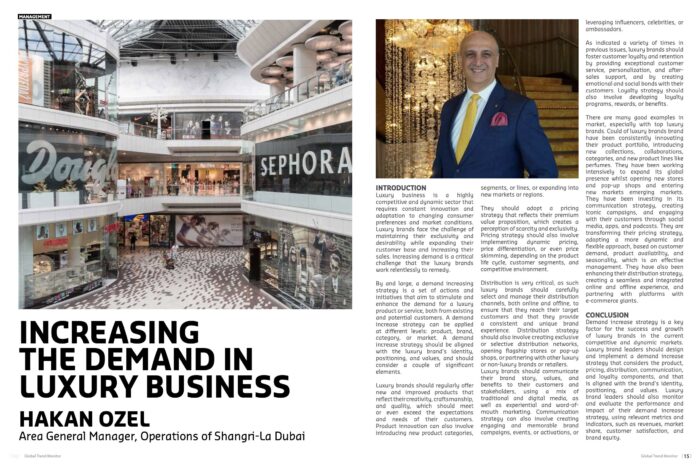Hakan Ozel, Area General Manager, Operations of Shangri-La Dubai
Introduction
Luxury business is a highly competitive and dynamic sector that requires constant innovation and adaptation to changing consumer preferences and market conditions. Luxury brands face the challenge of maintaining their exclusivity and desirability while expanding their customer base and increasing their sales. Increasing demand is a critical challenge that the luxury brands work relentlessly to remedy.
By and large, a demand increasing strategy is a set of actions and initiatives that aim to stimulate and enhance the demand for a luxury product or service, both from existing and potential customers. A demand increase strategy can be applied at different levels: product, brand, category, or market. A demand increase strategy should be aligned with the luxury brand’s identity, positioning, and values, and should consider a couple of significant elements.
Luxury brands should regularly offer new and improved products that reflect their creativity, craftsmanship, and quality, which should meet or even exceed the expectations and needs of their customers. Product innovation can also involve introducing new product categories, segments, or lines, or expanding into new markets or regions.
They should adopt a pricing strategy that reflects their premium value proposition, which creates a perception of scarcity and exclusivity. Pricing strategy should also involve implementing dynamic pricing, price differentiation, or even price skimming, depending on the product life cycle, customer segments, and competitive environment.
Distribution is very critical, as such luxury brands should carefully select and manage their distribution channels, both online and offline, to ensure that they reach their target customers and that they provide a consistent and unique brand experience. Distribution strategy should also involve creating exclusive or selective distribution networks, opening flagship stores or pop-up shops, or partnering with other luxury or non-luxury brands or retailers.
Luxury brands should communicate their brand story, values, and benefits to their customers and stakeholders, using a mix of traditional and digital media, as well as experiential and word-of-mouth marketing. Communication strategy can also involve creating engaging and memorable brand campaigns, events, or activations, or leveraging influencers, celebrities, or ambassadors.
As indicated a variety of times in previous issues, luxury brands should foster customer loyalty and retention by providing exceptional customer service, personalization, and after-sales support, and by creating emotional and social bonds with their customers. Loyalty strategy should also involve developing loyalty programs, rewards, or benefits.
There are many good examples in market, especially with top luxury brands. Could of luxury brands brand have been consistently innovating their product portfolio, introducing new collections, collaborations, categories, and new product lines like perfumes. They have been working intensively to expand its global presence whilst opening new stores and pop-up shops and entering new markets emerging markets. They have been investing in its communication strategy, creating iconic campaigns, and engaging with their customers through social media, apps, and podcasts. They are transforming their pricing strategy, adopting a more dynamic and flexible approach, based on customer demand, product availability, and seasonality, which is an effective management. They have also been enhancing their distribution strategy, creating a seamless and integrated online and offline experience, and partnering with platforms with e-commerce giants.
Conclusion
Demand increase strategy is a key factor for the success and growth of luxury brands in the current competitive and dynamic markets. Luxury brand leaders should design and implement a demand increase strategy that considers the product, pricing, distribution, communication, and loyalty components, and that is aligned with the brand’s identity, positioning, and values. Luxury brand leaders should also monitor and evaluate the performance and impact of their demand increase strategy, using relevant metrics and indicators, such as revenues, market share, customer satisfaction, and brand equity.
